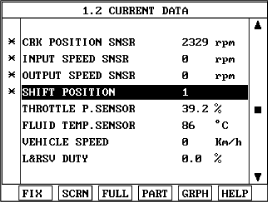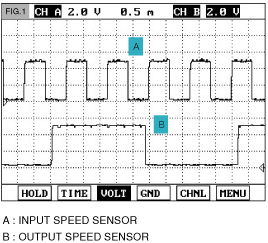Perform the "STALL TEST" with gear position "1"
Specification : 2000~2700 engine rpm

UD/C | OD/C | REV/C | 2ND/B | LR/B | OWC | |
P | ● | |||||
R | ● | ● | ||||
N | ● | |||||
D1 | ● | ● | ● | |||
D2 | ● | ● | ||||
D3 | ● | ● | ||||
D4 | ● | ● |
※ Low & Reverse Brake is released When the Vehicle speed over the 5 MPH(7Km/h)
Stall test procedure in D1 and reason
Procedure
Warm up the engine
After positioning the select lever in "D" ,depress the foot brake pedal fully after that, depress the accelerator pedal to the maximum
* The slippage of 1st gear operating parts can be detected by stall test in D
Reason for stall test
If there is no mechanical defaults in A/T, every slippage occur in torque converter.
Therfore, engine revolution is output, but input and output speed revolution must be "zero" due to wheel's lock.
If 1st gear operating part has faults, input speed revolution will be out.
If oupput speed revolution is output. It means that the foot brake force is not applied fully. Remeasuring is required.
Does "STALL TEST " within specification?

▶ Go to "W/Harness Inspection" procedure

▶ Go to "Component inspection" procedure
● Do not let anybody stand in front of or behind the vehicle while this test is being carried out.
● Check the A/T fluid level and temperature and the engine coolant temperature.
Fluid level : At the hot mark on the oil level gauge.
Fluid temperature : 176 °F~ 212 °F (80~100 °C).
Engine coolant temperature : 176 °F~ 212 °F (80~100 °C).
● Chock both rear wheel(left and right).
● Pull the parking brake lever on with the brake pedal fully depressed.
● The throttle should not be left fully open for more than eight second.
● If carrying out the stall test two or more time, move the select lever to the "N" position and run the engine at 1,000 rpm to let the A/T fluid cool down before carrying out subsequent.


